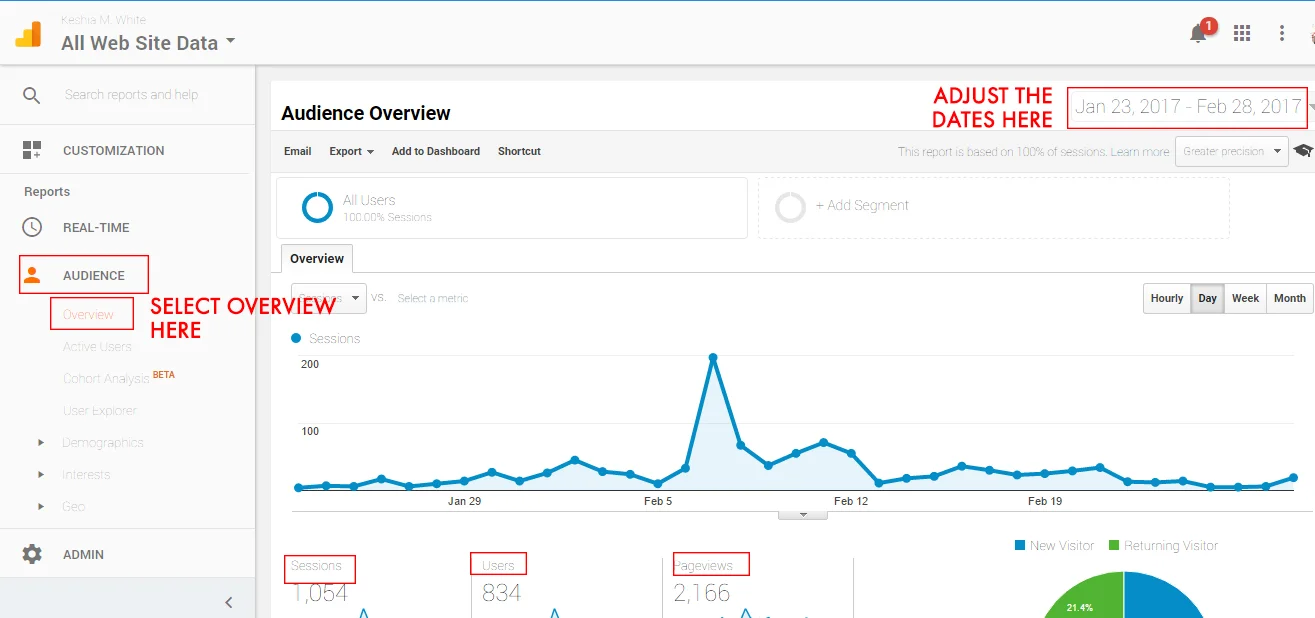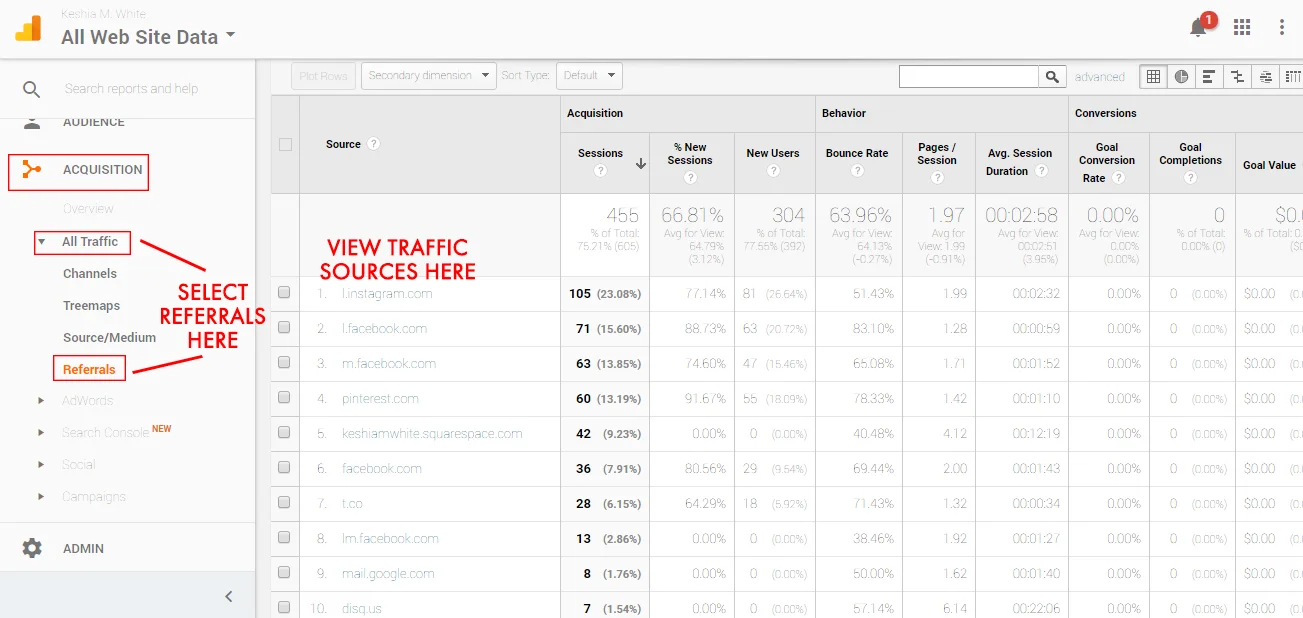How to Grow Your Blog Traffic with Google Analytics
Paying attention to your blog traffic is absolutely necessary if you want to generate income from blogging. Sure, if your blog is just a hobby for you, it doesn't matter how much traffic you have. However, if you have goals to monetize your blog, having an audience that's steadily growing is important.
I have been using Google Analytics to follow my blog traffic for years now. In the beginning, when I was just blogging for fun, I must admit, I wasn't paying much attention to my analytics at all. But over the last several months, I have been examining my analytics very closely because I'm much more serious about blogging now. I've been putting a lot of work into my blog content, so I've been very eager to see how my posts are performing. One of the reasons that I made the decision to switch from blogging on lifestyle topics to focus only on web design and blogging topics was because of my blog analytics. On my previous blog, my posts on web design and blogging tips performed much better than all of my lifestyle topics, with the exception of a handful of outfit posts. I used that data to make a decision on how I would to take my blog to the next level.
“Paying attention to your blog traffic is absolutely necessary to generate income from blogging.”
Below, I list the steps and the top metrics for you to monitor, so you can make informed decisions, like I did, to grow your blog traffic. This information is sooo useful because it helps you to ensure that you're not wasting your time with your blogging efforts because you'll have the necessary information to focus on exactly what your audience wants.
1. Install Google Analytics in your site
It's pretty easy to install Google Analytics because there are step-by-step instructions available on how to do it for the two major hosting platforms, Squarespace and Wordpress. Even if you have a platform with its own built-in analytics, you still need Google Analytics. This is because Google Analytics shows you data that goes much further back than the data that you get with the built-in analytics. You can also see more in-depth information on your website traffic sources, which is crucial when planning your promotion strategies.
2. Examine the most important metrics at least once a month
Audience
The audience metrics overview the number of people who are visiting your site each day, each week, each month, etc. You can adjust the timeframe, as you please, to show the specific time period that you want to examine. This information is crucial because it allows you to see if your traffic is growing, staying stagnant, or if it's decreasing. Under the audience overview section under the graph, you'll see the following:
Sessions: The number of visitors on your website; This number counts one visitor multiple times if they keep coming back.
Users: The number of unique visitors on your website; This number counts each visitor only one time, so it will be lower than the sessions number. This is the number that you will use when reporting your website visitors because it only counts each visitor once.
Page Views: The number of pages that have been viewed on your website; Examining this number is important because it helps you to tell if your content is captivating your audience or not. If they aren't viewing multiple pages on your website site, that isn't a good sign because it's showing that your content isn't drawing people in and they're barely looking at anything on your site before leaving quickly. If your page views are high, it means you're doing well at captivating attention and guiding your readers from one post to the next.
Pages/Session: The average number of pages that each visitor views each time during a visit to your website.
Avg. Session Duration: The average amount of time a visitor spends on your website.
Bounce Rate: The percentage of website visitors that view one page and then leave your website. A good bounce rate is 26-40%. However, 41-55% is the average bounce rate for most websites.
Below those numbers, you will the demographics of your audience, like their locations and what languages they speak. This information can be helpful if you're working on data to use in a media kit.
Acquisition
This is SO important because it helps you to know which places are generating the most traffic to your website. By knowing which sources are giving you the most traffic, you will know where to focus your promotion efforts. For the sources that are generating the most traffic, continue to promote consistently there. For the sources that generate the least traffic, look into ways that you can improve your promotional efforts. Do you need better photography? Do you need to write better social media captions? Are you interacting with your target audience enough? All of those are things to consider when you develop a strategy to improve how you promote your blog.
To find this information under "Acquisition," click on "All Traffic" and then click "Referrals."
“By knowing which sources give you the most traffic, you will know where to focus your promotion efforts.”
Behavior
Behavior shows you what content is really working for you. In this section, you're able to see which blog posts are getting the most views and which posts are attracting the most people to your website. You'll also be able to see which posts people are on the most when they decide to leave your website. To find this information, click "Overview" and then click "view full report" in lower right corner. The two metrics below are also in this section and you should take note of them, too:
Landing Pages: The first pages that visitors view when they visit your blog; This tells you which blog posts are attracting the highest numbers of visitors to your website, in the first place.
Exit Pages/Bounce Rate: The pages that visitors are on when they leave your blog; If there are certain pages in particular that have very high bounce rates over several months, that shows that those pages aren't captivating. Review those pages to see if you can make some adjustments to them to make them more captivating or you could simply decide to move away from those types of topics, if you're blogging on multiple topics.
3. Make adjustments to your website strategy based on what's performing best
I suggest posting consistently for at least a 3 month time period and then evaluating your results by closely examining the metrics that I named above. Once you evaluate what's working and what's not, you will have data to evaluate your blog strategy to make the necessary changes to grow your audience. Being able to examine your analytics helps you to understand what your audience likes the most. For the posts that are performing the best, capitalize on that by creating more posts that are similar. For the posts that are performing the worst, you may want to consider eliminating those topics (if you blog on several different topics) or you could add improvements to those posts to help them perform better. These changes will help you to see an increase in traffic because you're creating more of the content that you know your audience wants from you.
Have you already been examining your blog traffic with Google Analytics? If so, have you made any changes or improvements to your blog because of it? Share it in the comments below! For a template that you can use to track your progress throughout the year, download my free Google Analytics tracking calendar. It has blanks that you can type directly into so you can easily save it on the computer as you go! It allows you to track the most important numbers over a whole year in one place: number of monthly users, page views, the top 3 referrals, and the top 10 blog posts.









